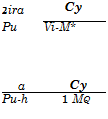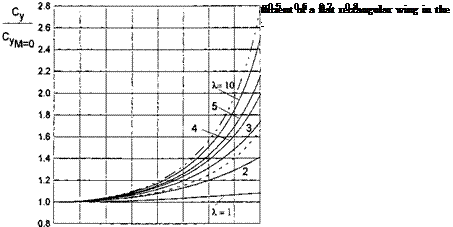Steady Linearized Compressible Flow Past a Wing of Finite Span
 |
|
A linearized version of a steady compressible flow around a wing at arbitrary relative ground clearances is described by the following boundary problem:
^ = at ix’z)^S’ У — h±0; (5.23)
^ = 0 at (x, z) Є 67, у = 0 + 0, (5-24)
where М0 is the Mach number of the oncoming stream. Using the Prandtl – Glauert transformation for the у and z coordinates, у’ = y/l — M2, z’ — z у/1 — M2, x’ = x, we obtain the following problem for an equivalent incompressible flow: • Equation:
![]() d2ip d2ip d2if _ &r’2 + dy’2 + ^’2 “
d2ip d2ip d2if _ &r’2 + dy’2 + ^’2 “
|
(*’,*’) Є G’, |
Note that the original Prandtl-Glauert rule implies that only the x coordinate is transformed into x’ = xj — M02. Here we prefer to retain the same chord length. In fact, both transformations lead to identical results. • Boundary conditions
 |
||
where /?м = /l — Ml As seen from (5.25)—(5.27), in a linearized steady state approach we account for compressibility by utilizing the results obtained previously for incompressible flow, but in a space “squeezed” both vertically and laterally. In particular, we consider an equivalent incompressible flow for a wing of smaller aspect ratio A’ = Л • /?м – In addition, the downwash on the surface of the equivalent wing is 1//?m times larger than in a corresponding compressible flow problem.[25] The aforementioned two factors are the same as in unbounded flow. A distinctive feature of the flow in ground effect is that the equivalent wing moves at a smaller ground clearance hf = h • /?м – To compare the influence of compressibility upon a wing in an unbounded fluid and in the extreme ground effect, we consider the simplest cases of a flat plate of infinite and small aspect ratio. For a two-dimensional incompressible flow the following are the expressions for the lift coefficient:
Turning to the compressible flow case by the of Prandtl-Grauert correction, we can obtain the following formulas for the lift coefficient:
 |
||
• In an unbounded fluid,
Now, it is easy to see that for a wing of large aspect ratio in both unbounded and bounded flow, there is an increase of the lift coefficient due to compressibility. However, in the ground effect, the influence of compressibility is more pronounced. For example, for a Mach number equal to a 0.8, an increase of the lift in the extreme ground effect is almost twofold compared to unbounded flow. It should be noted that Efremov [71], studying a thin foil, also came to the conclusion that, in proximity to the ground, the influence of compressibility leads to a noticeable increase in the lift coefficient. Such a conclusion can be easily interpreted in terms of the Prandtl-Glauert transformation, if one accounts for the fact that the equivalent wing flies closer to the ground, hf = hyj — M0[26].
м0
Figure 5.1 features a compressibility correction in the form of the ratio of the lift coefficients in compressible and incompressible flows versus the Mach number for wings of different aspect ratios in the extreme ground effect (Rozhdestvensky [41]). This correction can be shown to hold for a practical range of ground clearances (up to 0.15) with an asymptotic error of the order of 0(/i). For comparison, the curve corresponding to the unbounded twodimensional flow compressibility correction factor /?м = Л — M0[27], is plotted in the same figure (dashed line).
Now, we can proceed to the case of the small aspect ratio, for which in incompressible flow
• In unbounded flow, as predicted by the Jones theory,
![]()
![]()
 |
Су — 2 a%
In the extreme ground effect, see formula (3.69),2
r – —
y 6h ‘
Using the Prandtl-Glauert correction, i. e., replacing respectively Л, h, and a by A’ = /?мА, Ы — and о! — а//?м> we obtain a result, which
reads similarly for both unbounded and bounded flow, namely, for wings of a small aspect ratio, the influence of compressibility upon the lift coefficient becomes negligible.











